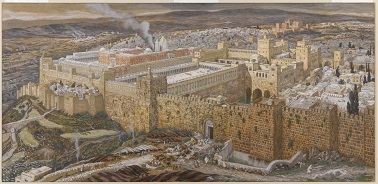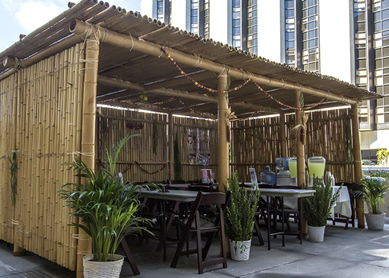The First Temple is one of the most famous buildings of the ancient world and also one of the most mysterious. The temple’s fame stems from the prominence it is accorded within a large number of biblical texts. These passages describe the temple as the sanctuary of Yahweh, the God of Israel, who is said to dwell within it (e.g., 1Kgs 8:11, 1Kgs 8:29; Isa 6:1). The mystery the temple poses to us today is that no trace of the structure has been unearthed in Jerusalem. This dearth of archaeological evidence is due to the fact that the building would have been located on the Temple Mount; excavations are not allowed in this area because the site is holy to both Muslims and Jews. For this reason, our understanding of the temple’s history, function, and appearance depends on how the sanctuary is depicted in the Bible and, indirectly, how other, contemporary temples were constructed by neighboring peoples in the Iron Age period (ca. 1175–586 BCE).
Who built the First Temple and what did it look like?
According to the Bible (1Kgs 6:37-38, 2Chr 3:2), Solomon built the First Temple between the fourth and eleventh years of his reign (ca. 950 BCE) at a site in the more elevated northern precinct of Jerusalem that David, his father, had purchased (2Sam 24:24, 2Chr 3:1). The description of the sanctuary provided in 1Kgs 6-7 indicates that the temple was constructed of unhewn stone. It had three sections that were laid out on a rectangular plan with an east-west axis. These consisted of a forecourt (ulām) with two large bronze pillars named Jachin and Boaz (1Kgs 7:15-22) at its entrance; a spacious central room (hekāl) that included a golden incense altar, table, and lamps; and an inner sanctuary, or Holy of Holies (debir), where two immense cherubs (winged feline creatures with human faces) flanked the ark of the covenant, forming a throne where God’s glory was said to be present (1Kgs 6:19, 1Kgs 6:23; 1Kgs 8:11; Ps 99:1). The temple also contained rich furnishings and decorations composed of cherubs, date palms, and blooming flowers (1Kgs 6:29). These symbols are reminiscent of the cherubs who guarded the entrance to the Tree of Life (Gen 3:24). It may be that the temple was designed to evoke images of the garden of Eden, a space that connected heaven and earth.
What’s also interesting about the First Temple is that it appears to be patterned on an architectural style found among peoples (the Phoenicians) that resided along the coastal areas in what is today Lebanon and Syria. The Bible states that Solomon contracted craftsmen from the Phoenician city of Tyre to build the temple and imported raw materials, such as cedar and cypress, from this same region (1Kgs 5:1-17). A series of Iron Age temples unearthed from various ancient cities in this area, such as at Tell Tayinat, ‘Ain Dara, and Aleppo, also have similar building plans and features. Thus, despite having no archaeological evidence of the First Temple in Jerusalem, temples do exist elsewhere from neighboring regions that help unravel the mystery as to how this structure may have appeared.
What happened to the First Temple and where are its contents now?
The First Temple would have stood alongside the royal palace in Jerusalem for nearly four hundred years. In 586 BCE, the Babylonian army burned the temple down after conquering Jerusalem (2Kgs 25:8-9; Jer 52:12-13). Between the time the First Temple is said to have been built by Solomon and its destruction, however, a number of changes to the sanctuary are described in the Bible, some portrayed as necessary improvements and others as violations to its sanctity. These include extensive renovations to the temple during the reign of Joash in the late ninth century BCE (2Kgs 12:1-16) and Josiah in the late seventh century BCE (2Kgs 23:4-14) that are viewed in a positive light by the biblical writers. But these renovations also include the decisions by Ahaz (ca. 735–715 BCE; 2Kgs 16:10-18) and his grandson Manasseh (ca. 697–642 BCE; 2Kgs 21:3-5) to incorporate foreign religious objects and practices into the temple, which are, in turn, condemned.
The fate of those items that were in the temple at the time of its ruin are unknown and has provoked speculation across the ages. The Bible states that the Babylonian army seized any objects of value from the sanctuary and broke them down for easier transport, including the great bronze pillars that had marked the entrance to the temple (2Kgs 25:13-17). It is possible that other items were carried away to Babylon as well. Around 515 BCE the Second Temple was built atop the location where the First Temple once stood.
Bibliography
- Hurowitz, Victor. “Inside Solomon’s Temple.” Bible Review 10.2 (1994): 24-37, 50.
- Bloch-Smith, Elizabeth. “‘Who Is the King of Glory?’: Solomon’s Temple and Its Symbolism.” Pages 18–31 in Scripture and Other Artifacts: Essays on the Bible and Archaeology in Honor of Philip J. King. Edited by M. Coogan, J. Exum, and L. Stager. Louisville: Westminster John Knox, 1994.
- Fritz, Volkmar. “Temple Architecture: What Can Archaeology Tell Us About Solomon’s Temple?” Biblical Archaeology Review 13.4 (1987): 38–49.





